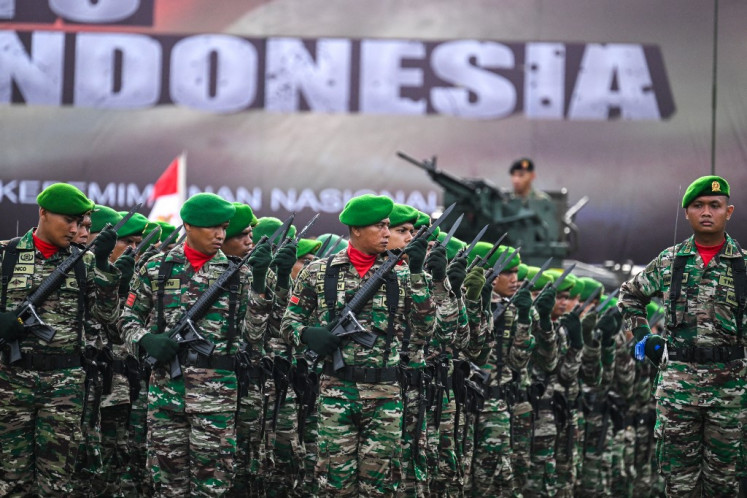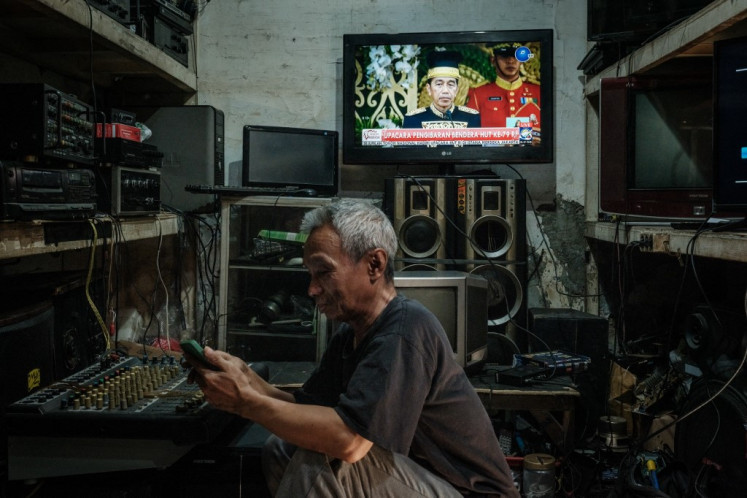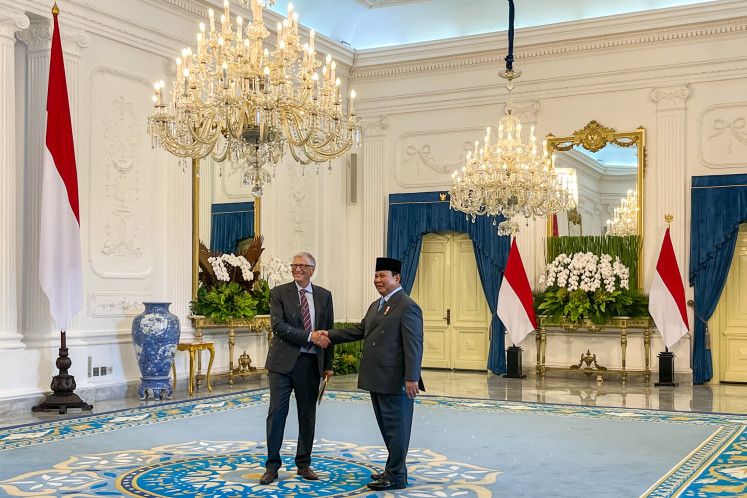Candi Bangkal: So much to see — and lose
Bangkal TempleOf the 2
Change text size
Gift Premium Articles
to Anyone

Bangkal Temple
Of the 2.5 million tourists who visit Borobudur every year, only 6 percent are foreigners. Yet the spectacular Central Java Buddhist monument is internationally known as Indonesia’s premier attraction. Could more be done to promote the nation’s cultural jewel?
The threats are clear. No need to kneel, no magnifier required. The ground is spongy and in places, waterlogged.
A partially exposed maze of tree roots under the structure threatens to undermine the soggy foundations. Above, wind and rain have worn away the waist of an already top-heavy building.
A barbed wire fence makes the place look like an internment camp, offset by manicured lawns and geometric shrubs better suited to a villa. Close, too close, is the 450 hectare Ngoro Industrial Park. Nearby high voltage powerlines and smokestacks show this is no pastoral idyll.
Bangkal Temple is 50 kilometers south of East Java’s capital Surabaya, the nation’s second-biggest city, yet the caretaker cannot recall any visits by foreigners and precious few by locals.
It is one of the country’s treasures. A precious, irreplaceable link to a splendid past, it’s suffering from such neglect that its very existence is in jeopardy. It’s officially protected but the care is passive.
Its history is a mystery.
“You won’t find Bangkal in the guide books and there’s little information about it elsewhere,” said environmental
activist and conservationist Suryo Prawiroatmodjo.
“However we can be sure of one thing. It’s definitely from the Majapahit era.”
Scrambling across loose bricks and up an uneven staircase, you enter the inner chamber through a narrow doorway. Ggrotesque kala (guardians) boggle their eyeballs at each entrance. Cryptic symbols on the walls defy the visitors curiosity. What do they mean? The puzzles add to the charm.
Here and there are niches where statues probably stood. Where are they now? In museums and private collections here and overseas, of course! East Java’s antiquities have been brutally, meticulously and systematically plundered.
A cone of flat bricks frames a central plate, high above. Peering down on you is the eight-pointed Majapahit sun symbol with a galloping horse and rider at the center, straddling what appears to be a dragon.
Perhaps it’s something else entirely — a rider triumphantly carrying a banner-topped spear? Or, the sun god Surya? It’s too gloomy and distant to be sure.
University of Indonesia student Nurmulia Rekso Purnomo has researched the history of the temple but found nothing to confirm its purpose or true origins. Assumptions’ have been made based on architectural style.
His work claims the shape of the temple is similar to those built during “the golden age of Majapahit” in the mid-14th century when the empire was ruled by Hayam Wuruk, the fourth king.
References to Java’s glorious Hindu-Buddhist worry the superstitious and the intolerant, and are a barrier to preservation.
Suryo serves guests with meals from the era on Majapahit-style pottery and doesn’t shout his enthusiasm from the rooftops, but works to promote wider interest. Apart from Majapahit meals and music he’s also recreating the wayang (puppets) of the time.
There are at least 32 known temples and scores of other royal shrines of the Singosari (1222 – 1292) and Majapahit (1293 – 1527) eras in central East Java. Not all are in such a bad state as Bangkal, but many are worse. Most are clustered around the meanders of Brantas River as it heads south, turns west and then north.
The watercourse was once so navigable and the floodplains so rich that the people who tilled the volcanic soil had time to create and invent.
This wasn’t subsistence living. Ceremony, art and innovation were blossoming before the kingdoms mysteriously crumbled.
Now the toxic Brantas is silted and vile, one of the world’s most polluted waterways, carrying disease and pestilence, instead of sustaining life. This sad, black stream of sludge once took sea-faring craft from deep in the hinterland to trade with the rest of Asia.
On Mount Penanggungan (remnants of the holy Indian Mount Mahameru magically flown to Java to keep the island intact) are at least 81 sacred sites spanning five centuries.
Only those on the lower slopes can be easily accessed. Others, yet to be revealed, lie smothered in vegetation, alive and dead.
Local villager Tri, who has climbed the mountain several times with his children, has seen signs of “unknown” sites near the summit.
On the other side of Ngoro Industrial Park, past a smoldering rubbish tip and bulldozers ripping up yet more forest, lies Gapura Jedong which inscriptions indicate t may have been built at the close of the 10th century.
This site has been given a make-over including manicured lawns and pretty bushes, fading signage of boring information — but no indication of the lives of the people who built the place.
We know the names of the kings and generals, but little of the folk who worshipped, worked here and built the powerful nation state that dominated Southeast Asia.
Also missing is a third gateway. It was there early last century — it isn’t now. In this area you have to be quick. If the pollutants and developers don’t get you, the vandals will.
— Photos by Duncan Graham









